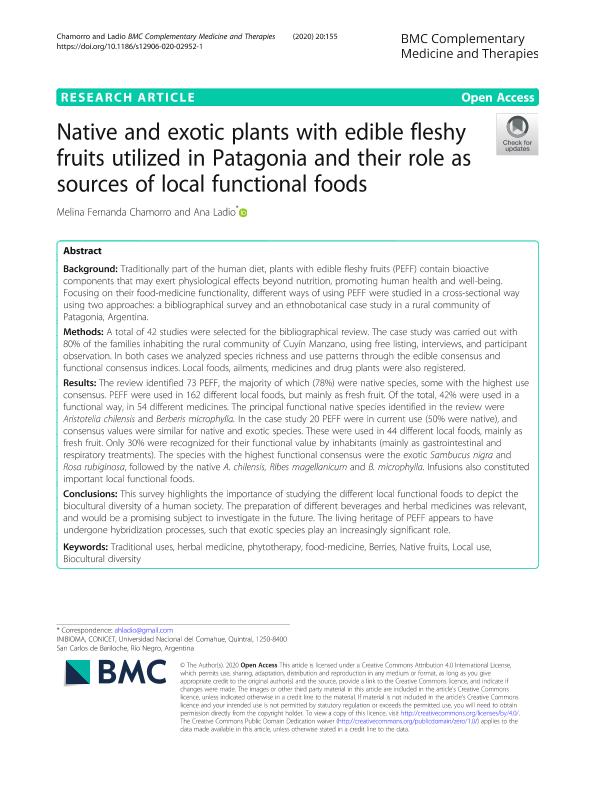Artículo
Native and exotic plants with edible fleshy fruits utilized in Patagonia and their role as sources of local functional foods
Fecha de publicación:
05/2020
Editorial:
BioMed Central
Revista:
BMC Complementary Medicine and Therapies
e-ISSN:
2662-7671
Idioma:
Inglés
Tipo de recurso:
Artículo publicado
Clasificación temática:
Resumen
Background: Traditionally part of the human diet, plants with edible fleshy fruits (PEFF) contain bioactive components that may exert physiological effects beyond nutrition, promoting human health and well-being. Focusing on their food-medicine functionality, different ways of using PEFF were studied in a cross-sectional way using two approaches: a bibliographical survey and an ethnobotanical case study in a rural community of Patagonia, Argentina. Methods: A total of 42 studies were selected for the bibliographical review. The case study was carried out with 80% of the families inhabiting the rural community of Cuyín Manzano, using free listing, interviews, and participant observation. In both cases we analyzed species richness and use patterns through the edible consensus and functional consensus indices. Local foods, ailments, medicines and drug plants were also registered. Results: The review identified 73 PEFF, the majority of which (78%) were native species, some with the highest use consensus. PEFF were used in 162 different local foods, but mainly as fresh fruit. Of the total, 42% were used in a functional way, in 54 different medicines. The principal functional native species identified in the review were Aristotelia chilensis and Berberis microphylla. In the case study 20 PEFF were in current use (50% were native), and consensus values were similar for native and exotic species. These were used in 44 different local foods, mainly as fresh fruit. Only 30% were recognized for their functional value by inhabitants (mainly as gastrointestinal and respiratory treatments). The species with the highest functional consensus were the exotic Sambucus nigra and Rosa rubiginosa, followed by the native A. chilensis, Ribes magellanicum and B. microphylla. Infusions also constituted important local functional foods. Conclusions: This survey highlights the importance of studying the different local functional foods to depict the biocultural diversity of a human society. The preparation of different beverages and herbal medicines was relevant, and would be a promising subject to investigate in the future. The living heritage of PEFF appears to have undergone hybridization processes, such that exotic species play an increasingly significant role.
Archivos asociados
Licencia
Identificadores
Colecciones
Articulos(INIBIOMA)
Articulos de INST. DE INVEST.EN BIODIVERSIDAD Y MEDIOAMBIENTE
Articulos de INST. DE INVEST.EN BIODIVERSIDAD Y MEDIOAMBIENTE
Citación
Chamorro, Melina Fernanda; Ladio, Ana Haydee; Native and exotic plants with edible fleshy fruits utilized in Patagonia and their role as sources of local functional foods; BioMed Central; BMC Complementary Medicine and Therapies; 20; 5-2020; 1-16
Compartir
Altmétricas




